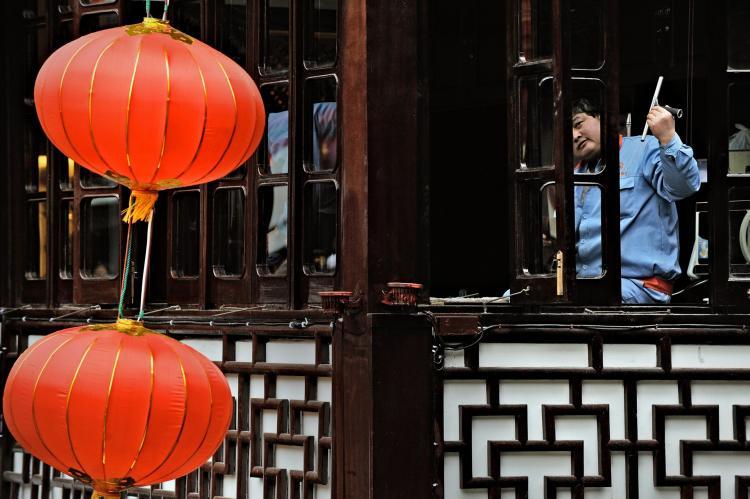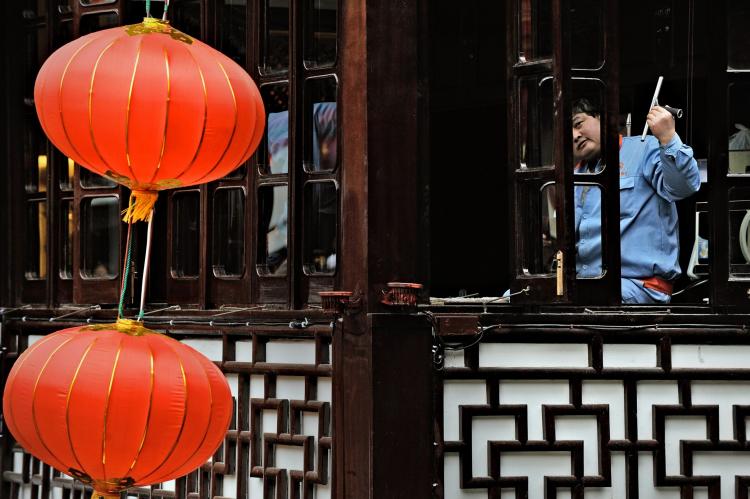The Chinese call the time span between December 23rd and the 30th “xiao nian,” the little New Year. Each family thoroughly cleans and spruces up their home in anticipation of the New Year, which this year falls on Feb. 13-15.
Besides cleaning, purchases for the festive days must be made: chickens, ducks, fish, meat, fruit, and sweets. In addition, people purchase gifts for friends and relatives. Children are outfitted in new clothes.
The entire family gets together on New Year’s Eve. Tradition in northern China demands eating many dumplings, called “jiao zi,” which sounds like the word for “togetherness.”
Southern Chinese feast on sweet rice flour cake, symbolizing a comfortable existence and progress, because the Chinese word for cake and progress sound the same, “gao.”
Another traditional food is finfish, because the homophone sounds like “abundance.” But the heads and tails must be left intact to assure wholeness. And exactly at midnight the fireworks begin.
Children wear their new clothes the first day of the New Year and wish their parents a Happy New Year. Children traditionally received gifts of money, usually in special red envelopes. The second and third day of the New Year are reserved to visit family and friends, to extend New Year’s wishes.
At this time in China, roads are customarily crowded with people watching lion and dragon dances. These dances symbolize a request for a good harvest and the dragon stands for rain. Lions wagging their heads are supposed to keep monsters at bay.
Monster Shui
Some new year’s traditions originate from tales involving monsters. One is of the monster Shui, which sneaks into the homes at night and caresses the children’s foreheads, awakening them and giving them a headache.
Children so touched will end up insane, prompting parents to hold a protective bedside vigil at their children’s sleeping space. This is called the “Shui Watch.”
According to folklore, an honest and good couple, childless for many years, lived in Zhejiang Province. They eventually had a child, though they were already quite old.
One New Year’s night the parents kept themselves awake to protect their child from Shui. They played with red paper and eight coins in an attempt to stay awake, but eventually parents and child fell asleep. The coins, wrapped in red paper, fell to the child’s pillow. Monster Shui appeared and, just has it reached to caress the child’s forehead, the parents awoke. Shui, realizing its attempt on the child had failed, grabbed the red envelope and fled. The parents told the story to every villager who would listen. From then on all parents placed red envelopes with coins onto their children’s pillows. The money is called “Ya shui qian,” or money to defeat the Shui monster.
The custom goes back to the Han Dynasty. Coins during that era had engraved on one side words such as “To keep calamities at bay and dispel bad things,” or “Long life, wealth, and luck.” The backside of the coins showed animal images, like a dragon for strength, a phoenix for power, a twin fish for wealth, or a tortoise for long life.
Interval between January 1 and 15th
According to the Chinese lunar calendar, the interval between January 1st and 15th is traditionally the most auspicious for Chinese people. This is the time when they show deities added respect. All people, from the common folk to the emperor, burned incense on the first of the lunar year. Burning incense pleads with the gods to accept the rising smoke as a sign of respect. This custom still holds in today’s Taiwan where the temples are overfilled on New Year’s Day. The numbers of temple-goers in the Mainland is on the rise once again.
Customs at home demand an offering of fruit, placed in the middle of the living room, accompanied by prayers of thanks to the gods on Earth and in the heavens. One also remembers one’s ancestors in prayers.
Though house cleaning and preparations are de rigueur between December 23 and 30th, one must not make order or clean anything betweeen January 1st and 5th, thus not sweeping the new good luck out door. One must also avoid doing laundry on January 1st or 2nd, because those are the water gods’ birthdays. And, a married woman may only visit her husband’s relatives accompanied by her husband only on January 2nd or 3rd. Doing so on the 1st, 4th or 5th could plunge the family into destitution or other bad luck.
Chinese New Year celebrations conclude with the Lantern Festival on January 15th (28th February) according to the Chinese lunar calendar.


Friends Read Free